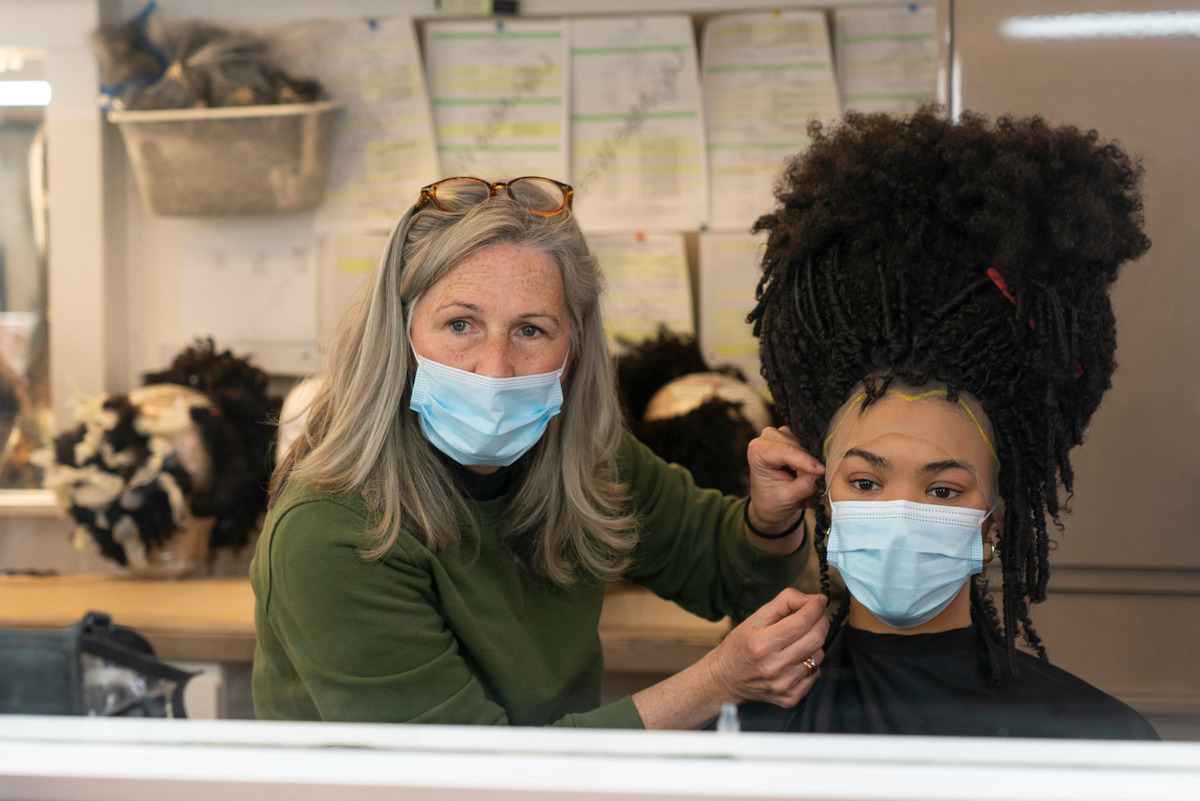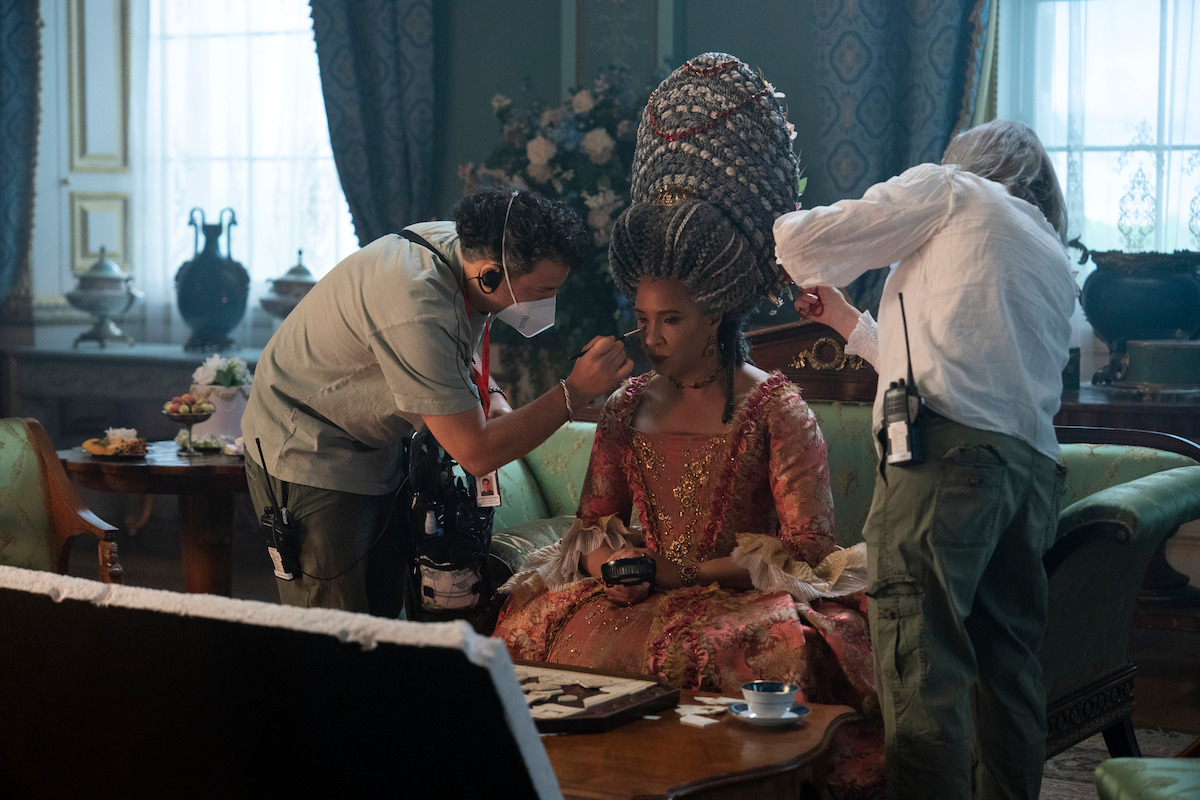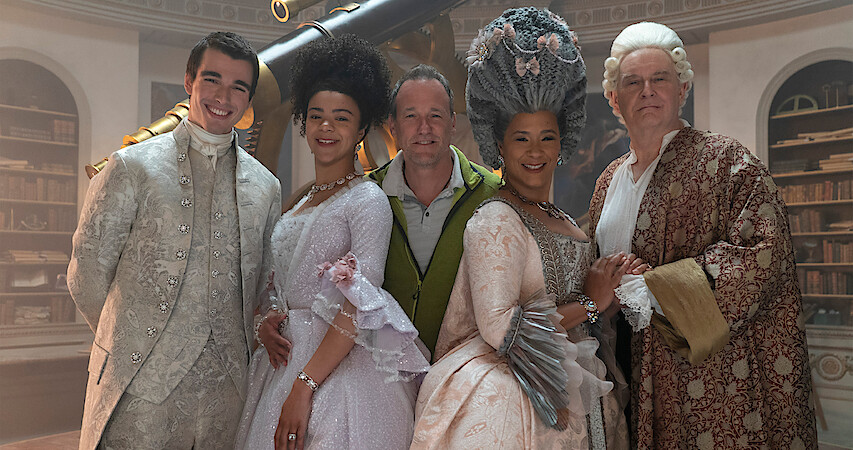The Higher the Hair, The Closer to God: On Queen Charlotte’s Wigs
Jacqueline Johnson / University of Pittsburgh

When Julia premiered on NBC in 1968, Diahann Carroll became one of the first Black women to star on a network television series. Audiences had a range of reactions to Julia; however, with her stylish clothes and coiffure, it was hard to deny that the character was chic.[1] Prior to the pilot airing, Carroll and creator and executive producer Hal Kanter exchanged several missives back and forth. In one letter, Kanter assuages Carroll’s concerns about having her hair competently styled. Kanter writes that the stylist they selected to work with Carroll had previously worked with “Lena Horne, Eartha Kitt and other Negro ladies.”[2] He goes on to relay that the stylist suggested that Carroll wear a wig. Wigs, of course, have long been a part of creating characters on screen in film and television.[3] Carroll understood that for Black women hairstyling had large stakes, and in the years since Julia went off the air Black women’s wigs on TV have continued to have wide cultural reverberations.
In this short essay, I want to use the Netflix original series Queen Charlotte: A Bridgerton Story (2023) to explore how wigs produce ideas about race and gender by mediating between artifice and authenticity. In both Queen Charlotte and Bridgerton (2020-), the ruling monarch has come to be known by her elaborate, gravity-defying wigs. In addition to being fodder for blog posts from viewers and critics and social media discussion, Netflix and Shondaland have used the series’ wigs as the focal point for a range of paratextual material from behind-the-scenes videos to Tudum articles to merchandise. These wig paratexts construct a discourse of authenticity around an innately artificial object.
My analysis is in line with what Sarah Mesle has called Critical Hair Studies. Mesle writes,
“Critical hair studies, in my mind, is [a] special branch of gender studies that, when partnered with media analysis, finds in TV hair a barometer for what kind of reality, what kind of relation, a given show can imagine for its (especially women) characters. It’s a part of gendered, raced, world building; how a show teaches us about what, in its portrait of gender, counts as real.”[4]
A critical hair analysis of Queen Charlotte reveals the overlapping discursive functions of the wigs in the series. 1. They mediate between the “real” history of Queen Charlotte’s marriage to George III and the historical fantasy offered by the adaptation. 2. Wigs are a part of Rhimes’s long-standing interest in dissecting how women attain and keep hold of power in both interpersonal relationships and institutions. 3. The wigs are an extension of the series’ larger approach to race; they highlight the visual markers of racial difference, and then safely integrate them into the larger structure.
In the above video, Nic Collins (Hair and Makeup Director) and Giorgio Galliero (Asst. Hair and Makeup Director) discuss the process behind making wigs for the elder version of Queen Charlotte’s character. In one of their most fantastic creations, the back of which is constructed through several individually rolled curls, two gray lovebirds sit atop Queen Charlotte’s coiffure at the opera. For Collins and Galliero, placing the two lovebirds on top highlights the character’s loneliness in her marriage and in her role as monarch. While Charlotte and George love each other, his mental illness also isolates both characters. Behind-the-scenes content like this does more than highlight the incredible work of below-the-line professionals; it also works to further enhance the themes of the narrative for viewers. Since viewers follow Queen Charlotte in two timelines, we can see how her wigs change over time and grow more elaborate as they become part of her armor. Rhimes, who wrote almost every episode of the prequel series, has explained that she wanted to both disrupt the traditional happy ending of the romance and to fill in the outline that history has given audiences about these figures. The wigs help actualize both of these goals.

Further, the Bridgerton universe is not Rhimes’s first foray into using wigs to examine Black women’s agency and relationship to beauty. For example, during How to Get Away with Murder’s (ABC, 2014–2020) first season, Annalise Keating’s (Viola Davis) removal of her wig before confronting her White husband about his infidelity fostered an intimate public with Black women viewers who recognized the layers of meaning embedded in Keating’s wig removal. As Kristin Denise Rowe illustrates this scene is part of a small group of representations of Black women’s hair in the mid 2010s that “[offer] a nuanced take on hair as a space of agency, negotiation, and embodied experiences of beauty.”[5] Queen Charlotte: A Bridgerton Story takes the television showrunner’s engagement with Black women’s hair to new heights (literally!).
Most resonant for my analysis, is the decision to include a range of hair textures and styling methods in the wigs. Rhimes as well as Collins and Galliero have been explicit about this choice and the creative team’s desire to use hair to convey that people of color belong in this world. The wigs were also quite personal for cast members. In an article for Tudum, Amarteifio told Netflix,
“My favorite part about my hair and makeup is the fact that my own hair texture is represented in a period style, which is really not common. To be able to wear something that is so elegant and beautiful, and I’m also represented — obviously it’s a wig, but it’s not a straight wig. I can still have my curls and the coils and it’s still as elegant and as bold, probably more so, having something that looks so different. It’s a real privilege to be able to wear this.”
Statements like this illustrate how the wigs are an important component of the affective dimensions of representation the show seeks to elicit. The incorporation of Black hair textures and styling methods is meant to resonate with viewers excited to feel seen in the series’ aesthetic. However, beyond resonance, the wigs signal the larger political project of the Bridgerton universe and Shondaland. Hegemonic systems can make space for Black women and Black women can be visible within that space, but their difference–as represented by the various wig textures–must be incorporated within the larger structure and the roots of that structure continually reinforced.

Though Queen Charlotte: A Bridgerton Story has come to an end, the queen’s wigs will continue to astound in season four of Bridgerton, and more importantly, they will continue to complement the story. While this short piece has merely scratched the surface of the semiotic function of the wigs in the Bridgerton universe, it is my hope that this brief essay sparks wider discussion about the meaning of hair on screen.
Image Credits:
- Hair and Makeup Designer Nic Collins with India Amarteifio who plays a young Queen Charlotte. Behind-the-scenes hair styling photo from Queen Charlotte: A Bridgerton Story. Source: Tudum
- “On Set with Queen Charlotte: Hair Story” from the Shondaland YouTube page. On Set with Queen Charlotte: Hair Story” YouTube video. Source: Shondaland
- Golda Rosheuvel (older Queen Charlotte) receiving a touchup from the hair and makeup teamBehind-the-scenes hair styling photo from Queen Charlotte: A Bridgerton Story. Source: Tudum
- Both sets of Charlotte and George with director Tom Verica. Cast photo. Source: Tudum
- See Bodroghkozy, Aniko. “‘Is This What You Mean by Color TV?’: Race, Gender and Contested Meanings in NBC’s Julia,” in Private Screenings: Television and the Female Consumer, ed. Lynn Spigel and Denise Mann (Minneapolis: University of Minnesota Press, 1992). 143–68. [↩]
- Letter from Hal Kanter to Diahann Carroll, October 27, 1967, Hal Kanter Collection, Box 18, Folder 1, Wisconsin Center for Film and Theatre Research, Madison, WI. [↩]
- See McLean, Adrienne L. All for Beauty: Makeup and Hairdressing in Hollywood’s Studio Era. Rutgers University Press, 2022. [↩]
- Mesle, Sarah.”Dickinson’s Hair.” Dear Television (blog). Los Angeles Review of Books. January 21, 2021. https://lareviewofbooks.org/article/dickinsons-hair/. [↩]
- Rowe, Kristin Denise. “’Nothing Else Mattered After That Wig Came Off’: Black Women, Unstyled Hair, and Scenes of Interiority.”: Black Women, Unstyled Hair, and Scenes of Interiority.” Journal of American Culture 42, no. 1 (2019). [↩]